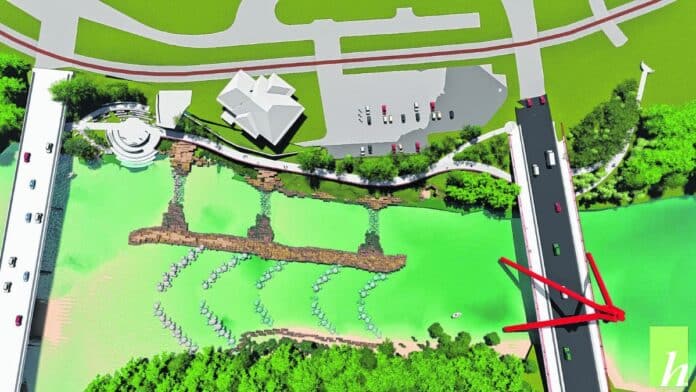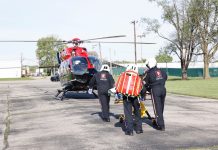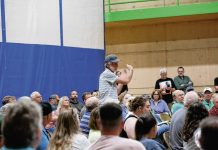
Columbus is continuing to pursue its riverfront project, though some officials are starting to echo the doubts of some constituents as costs continue to increase.
The Columbus Redevelopment Commission voted Monday to amend its contracts with both Hitchcock Design Group and CORE Planning Strategies for their work on the project. The amended contracts include additional fees and services.
City councilman Tom Dell estimated the project’s overall cost at being $6 million to $8 million and asked, “Are we sure we’re going to get this thing done?”
Dell said community members have asked the same question, as well as questions about the amount of money spent so far and how much more will be spent. He then asked if the city would be able to “get this project off the ground” with the additional funds that were being considered.
[sc:text-divider text-divider-title=”Story continues below gallery” ]
Randy Royer with Hitchcock Design Group said that he feels positive about the direction the project is going, despite bureaucratic obstacles it has faced along the way.
“It’s a very convoluted mess, but I do feel very confident that at this point, we’re almost there,” he said. “… If we didn’t feel like we saw a light at the end of the tunnel, we wouldn’t be here, asking for more money.”
Redevelopment director Heather Pope said that for Hitchcock, the additional fees include a fixed rate of $115,200 for services (to be billed upon the project’s completion) and $3,000 for reimbursables (if needed) for a total not-to-exceed amount of $118,200. She said that the city hopes to come in under this amount.
For CORE Planning Strategies, the additional fees include a flat fee of $161,000 and a reimbursable allowance of $7,500.
“This is not the first time that we’ve come in front of you and asked to amend the contracts, but again, we’re in uncharted territory here with the regulatory agencies, and it’s just taking some time,” Pope said. She said that the city has spent some of the money that it had expected to use if they were further along in the project.
Commission president Sarah Cannon said that the contract amendments are a result of additional requirements from the Department of Natural Resources.
Jason Larrison of CORE Planning Strategies explained that the Indiana DNR doesn’t have a “playbook” for making decisions about “in-water recreation,” which is a major component of the project. This has led to a lot of back and forth with the state.
“We’ve had to conduct additional studies to provide information to them to validate that the in-water recreation … is not going to be detrimental to the river’s health, that the project as designed by Hitchcock Group and their consultants, sub-consultants provides for a healthy river that allows for fish passage, allows for habitat to be created, doesn’t negatively impact the river flow in creating the recreational component,” he said.
The work done with the DNR and the United States Army Corps of Engineers over the past year has been more “than what could’ve been reasonably anticipated,” Larrison said. During the process, DNR has started to develop its playbook for in-water recreation, he said.
The project has had five redesigns, which has been time-consuming for those involved, Royer said.
Every time DNR makes a request, “It’s not simply just erasing a line on a sheet of paper. It’s reengineering the whole project,” Pope said.
And these requests didn’t all come at the same time, she added.
Staff and leadership changes at DNR have meant that they’ve had to spend additional time getting different people “up to speed” with the project and its history, which can also take a while, Royer said.
“The engineering teams have been out of money for months, and we’ve been pushing to get this through, to get the DNR permit,” he said. “And now, we’re just asking for some compensation to take care of that, because we had no idea we were going to have to design it so many times and then to get us through, because … IDEM and the Corps of Engineers have changed their process in the last year.”
However, he did note that getting the permit from the DNR was the “big hurdle” and that they do not anticipate as much pushback from the other two agencies.
Dell asked if the consultants if they think the DNR or engineers will request any more revisions on the project.
“You guys say we’re at the finish line, but I’ve seen that finish line move a lot over the course of this whole project,” he said.
While he believes the riverfront is a good project that should be seen through, commission member Al Roszczyk said he is concerned about cost and whether it would come in at $8 million or even $12 million.
Larrison said that he believes they’re “reaching the finish line” on costs that come from the regulatory side of the project and are not expecting “wild cost swings” for construction. The consultants do not expect the Corps to request significant changes or redesigns.
Between the costs of mitigation and additional services, the process of working with the DNR has likely added about $1 million to the project, Royer said. That was “unfortunate” and “totally unforeseen,” he said, but added that the team can find some ways to save costs in the future, once they’ve finished with the permitting process.
Pope said that once bat season ends, on-site staging and other work can begin for the project.
An updated cost estimate from Taylor Bros. Construction will also be needed in the future, Royer said.
“I’ve kind of been holding back on that, because right now, in the construction industry, numbers have been all over the place because of politics and everything that’s going on right now,” he said. “And so a cost estimate done today might not be worth much in three months. … We’re probably in the same ballpark as what we’ve said in the past, but I’m going to have them do one more estimate before it goes to bid and once we get all our permits.”
Commission member Kyle Hendricks, who was on the original planning group for the project, said that while he still believes in the project, he thinks the city should maintain the option to walk away from the project if necessary.
“If it does become the wrong project, we lose faith in this project to do what we hope it will, then I think that’s something that we should have the opportunity to consider at any point in the process, before the final lever is pulled,” he said. “I don’t know if we’re there yet; I have faith that this project is the right one. But I still think that there are a lot of unknowns.”
Given the number of ecological and safety concerns facing the riverfront — including the low-head dam, an eroding city dump and an exposed sewer line — it’s not a matter of if the work will be done but when, Royer said.
“Last year or the year before, one of the large trees, it eroded and fell over and hit Second Street bridge,” he said. “… Slowly but surely, Mother Nature’s just taking it apart. So if it’s not done today, it’s going to be done down the road at some point.”
City council president and commission liaison Elaine Hilber said that she believes that the majority of city council supports the project and wants to see it through. However, she’s also heard the same concerns from the community as Dell and is expecting pushback.
“I still think that this is something that we need to do and something that we need to move forward with and support,” she said. “It’s just not going to be fun.”
Hendricks said that as officials move forward, the main question should be “Do we still believe that this project is the right project for the city?”
“We all want to see this project completed and finished,” he said. “I think the question that we should all ask at this juncture is … ‘Do we still trust the project to be successful in the way that we want it to be successful for the community?’ And if we think so, then the night is always darkest just before the dawn.”
[sc:pullout-title pullout-title=”About the project” ][sc:pullout-text-begin]
According to the Columbus riverfront project website, major design concepts for the project include:
- Accommodating the probable realignment of State Road 46
- A river walk on the east bank with a connection to the People Trail
- Improved three-dimensional connectivity
- Nature-themed play space on the west bank
- In-river improvements
The project also calls for overlooks of the East Fork White River, the removal of the low-head dam and an in-water recreation area.
Mayor Jim Lienhoop has said in the past that the riverfront project will create 89 construction-related jobs, invest $1.6 million in the local economy through local income tax during construction and help generate $280,000 in state and local taxes.
He said during his 2021 State of the City address that the city has received a conditional permit from the Indiana Department of Natural Resources and is working to coordinate that permit with the U.S. Army Corps of Engineers and the Indiana Department of Environmental Management.
More information about the project is available at columbusriverfront.org.
[sc:pullout-text-end]




